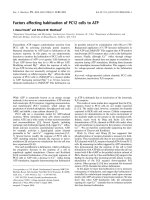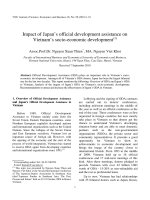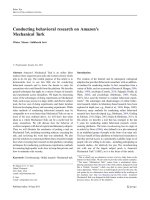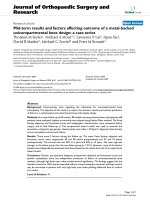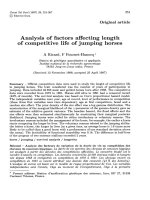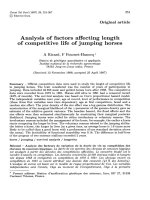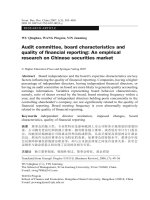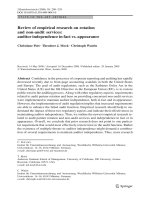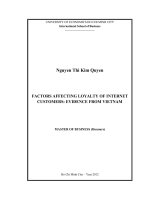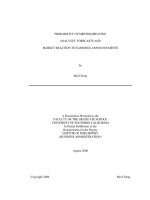Empirical research on factors affecting probability of delisting on vietnam’s stock market
Bạn đang xem bản rút gọn của tài liệu. Xem và tải ngay bản đầy đủ của tài liệu tại đây (531.66 KB, 95 trang )
TABLE OF CONTENTS
LIST OF TABLE AND FIGURE
Figure and Table
Figure 1
Figure 2
Figure 3
Figure 4
Figure 5
Figure 6
Table 1
Table 2
Table 3
Table 4
Table 5
Table 6
Table 7
LIST OF ABBREVIATIONS
Abbreviation
s
Full phrases
2
SSC
State Securities Commission of Vietnam
HOSE
Ho Chi Minh Stock Exchange
HNX
Hanoi Stock Exchange
UPCOM
Unlisted Public Companies Stock Exchange
M&A
Merger and Acquisition
IPO
Initial Public Offering
P/E
Price to Earnings Ratio
P/B
Price to Book ratio
ROA
Return on Assets
ROE
Return on Equity
VND
Vietnam Dong
NYSE
New York Stock Exchange
AMEX
American Stock Exchange
NASDAQ
National Association of Securities Dealers Automated Quotation
System
3
ABSTRACT
The number of delisting firms in Vietnam stock market has dramatically
increased in recent year. There have been numerous studies in the world concerned
with the determinants for delisting and the effect of delisting on the market in
general, the company itself and the investors. The main objective of this research is
to identify the factors affecting delisting probability of companies listed in three
Vietnam stock exchanges: HOSE, HNX and UPCOM over the period of 2009 –
7/2014. More specifically, the research is concerned with these variables that are
indicators of firm’s financial ratios and managerial characteristics. Logistic
regression model was used to distinguish the difference between delisted and listed
firms. After running the model, major findings revealed: (1) the higher Net Income,
the greater Total Assets and the lower Debt ratio with the renting of BIG4 as
auditor, the less likely a firm will delisted; (2) the smaller the number of Board of
Directors, the few number of large shareholders and the lower number of Master
Degree and female member in Board of Management, the greater the likelihood the
firm will go private. Also, the finding showed that if the shareholders in companies
are foreigners and state, the firms will less likely delisted. The results found in this
paper have numerous important implications for establishing stock markets in
emerging economies.
4
Chapter I: INTRODUCTION
1.1. Rationale:
For more than 14 years of development, Vietnam stock market has achieved
some impressive milestones:
To begin with, the organizational structure of the market has been more and
more completed with three Stock Exchanges. Ho Chi Minh Stock Exchange
(HOSE) operated on July 28, 2000, while Hanoi Stock Exchange (HNX) officially
launched on March 08, 2005 and Unlisted Public Company Market (UPCOM) was
opened on June 24, 2009;
Another achievement is that there has been a growth in number of listed
companies in Vietnam stock market, including both large-cap and small-cap
enterprises. Until July 31, 2014, there are 304 stocks listed in HOSE; 359 stocks in
HNX with total market capitalization of more than VND 89,000 billion. Meanwhile,
151 public companies register transactions in UPCOM with total transaction value
of VND 21.326 billion;
Additionally, the total market capitalization has been developing
continuously. Until July 25, 2014, the total capitalization of Vietnam’s stock market
is VND 1,100,000 billion, comprising Ho Chi Minh Stock Exchange (89%) and
Hanoi Stock Exchange (11%). In particular, this figure of HOSE reached VND
979,000 billion, which is VND 136,895 billion higher than that of the previous year.
Whilst, value of capitalization in HNX was VND 121,000 billion, increasing by
VND 14,130 billion compared to 2013.
Therefore, the stock market has become an important channel of mobilizing
capital for enterprises as well as an attractive investment channel for investors.
Until July 25, 2014, the total capital of the Vietnam stock market was VND
1,700,000 billion, which is successfully mobilized in 14 years of operation. In
particular, Government mobilized about VND 1,000,000 billion through
government bonds; businesses did approximatelyVND 700,000 billion through the
stock market during this period. 1,300,000 accounts of investors including
5
1,282,831 domestic investors, 17169 foreign investors were opened on Vietnam’s
stock market till July 20, 2014.
On the other hand, Vietnam Stock Market has to face up with a serious
phenomenon that can hinder and threaten the sustainable development of the
market. This is delisting problem in three Stock Exchanges: HOSE, HNX and
HOSE. The number of delisting companies in these three Stock Exchanges is
increasing annually.
From 2009 – 7/2014, there are 161 delisting companies that includes 69
voluntary delisting companies and 92 involuntary delisting companies
This situation affected adversely to stock market, investors and the company
itself. Specifically, the delisting degrades the image of the companies in the eyes of
investors, customers and partners.
Moreover, due to no completed research on delisting, State Security
Commission (SSC) as well as Stock Exchanges has inactively responded to
delisting proposal. Since 2009, although numbers of delisting companies have
increased significantly, there was no adjustment from management body to restrain
the negative impacts of delisting and delisting phenomenon.
In fact, the phenomenon of delisting is to a certain extent a common
occurrence in developed economies as well. However, the difference is that there
has been a myriad of worldwide researches on delisting problem.
In contrast, there is no academic research paper that evaluates the
determinants of delisting risk and its consequences on Vietnam’s stock market.
Therefore, it is necessary to have research papers to investigate the factors
affecting delisting risk as well as to assess consequences and influences of delisting
issue. This research will also help SSC and Stock Exchanges actively response to
delisting cases as well as reduce the number of potential delisting firms.
From these above analyses, “Empirical research on factors affecting
probability of delisting on Vietnam’s Stock Market” is new research topic,
valuable and practical to solve the problem of delisting on Vietnam’s Stock Market.
6
1.2. Research objectives and scope:
Our empirical research implemented to analyze performance of each
enterprise at the end of the year before delisting event in order to identify the
determinants of delisting probability. Also, we found both subjective and objective
reasons which have significant influence on both voluntary and involuntary
delisting of enterprises on Vietnam’s stock market. All these objectives are carried
out towards limiting and reducing enterprises’ probability of delisting so that we
reach the final goal of helping firms to balance, control and maintain their positive
performance on the stock market.
We choose to localize our research on delisted enterprises of three Stock
Exchanges: Ho Chi Minh Stock Exchange (HOSE), Hanoi Stock Exchange (HNX)
and Unlisted Public Company Market (UPCOM) as representatives of Vietnam’s
Stock Exchanges until July 31, 2014. 161 delisted enterprises and 40 biggest
capitalized companies were selected to make a comparison. For the former, all data
is collected at the end of the year before delisting event, whereas database of the
latter was taken in 2013. Both voluntary and involuntary delisting were studied
based on two major indicators, namely financial ratios and corporate governance.
1.3. Research questions:
There are three questions that this research is going to exploit.
1. Whichfactors affect delisting probability on Vietnam’s stock market?
2. Whichfactors affectthe probability of voluntary delistingon Vietnam’s
stock market?
3. What factors affect the probability of involuntary delisting on Vietnam’s
stock market?
1.4. Research methodology
1.4.1. Sample
The research team first collects the population of all delisted firms on
Vietnam’s stock market between 2009 and July 2014. The data is completely
7
secondary, which is mainly taken from companies’ financial statements and annual
report as well as from some journals and newspapers. The delisted firms are
classified in two big categories: voluntary delisting and involuntary delisting firms.
Then, based on specific reasons for delisting, delisted firms are divided into some
kinds of sub-categories.
From firm’s financial statements and annual report, the research team
extracts the data into financial indicators and managerial characteristics to establish
assessment criteria for delisting
1.4.2. Methodology
Quantitative research methodology is used effectively to analyze the data. As
one of the most popular model when researching on delisting phenomenon, logistic
regression model is chosen to distinguish the delisted and listed firms based on
management criteria and financial ratiosin order to determine the factors affecting
probability of delisting in Vietnam.
1.5. Research Structure
The research is divided into 6 main parts together with tables, figures and
appendix.
Chapter 1: Introduction
This part provides the information about rationale of the research, research
objectives and scope, research questions and research methodology. This chapter
also contains the research structure to help readers have big picture about the
research.
Chapter 2: Literature review
This chapter gives information about previous researches in the past that will
be the knowledge based for the research. Based on this part, the research team and
the readers can make some comparisons to see the differences between delisting in
Vietnam Stock Market and delisting in other countries in the world.
8
Chapter 3: Overview of Vietnam stock market and its delisting phenomenon in
recent years.
This chapter contains two big parts that includes Vietnam Stock Market
Overview and Delisting phenomenon in Vietnam.
In Vietnam Stock Market Overview, it focuses on analyzing listing
requirements and delisting requirements in HNX, HOSE and UPCOM. Regard to
delisting phenomenon, the research studies about features of delisting in HNX and
HOSE to figure out delisting characteristics in these stock exchanges.
Chapter 4: Research methodology
This section provides the information about research data including objects,
scope, and research methodology and research model.
Chapter 5: Findings
In this part, research team analyzes the descriptive statistics and the model
that is applied in the research.
Chapter 6: Recommendations and conclusions
From the findings in chapter 5, the research team makes conclusion about
delisting on Vietnam’s stock market and some recommendations for relevant parties
to have quick responses and actively encounter with this issue.
9
Chapter II: LITERATURE REVIEW
The decision to go public is a popular topic of corporate finance research
paper. The reverse phenomenon – delisting – is less studied despite its importance.
During the past few years, delisting has become a common phenomenon in
Vietnamese stock market. According to the State Security Commission of Vietnam,
since 2009, Vietnamese market has witnessed more than 160 delisting cases in both
Hanoi and Ho Chi Minh stock exchange. However, there was a handful of research
has been conducted about this subject in Vietnam; thus, the recent wave of delisting
is still a puzzling issue that needs to be studied on.
This delisting phenomenon is more interested in at the developed stock
markets. However, existing research appears to be very fragmented, as scholars tend
to concentrate separately on different aspects of delisting. While some academics
studied on the classification or specific types of delisting (going-private
transactions, going-dark strategies, involuntary delisting or termination of a crosslisting), others prefer the determinants, effects on firm’s governance mechanisms
and organizational structure of delisting and the relationship between delisting and
corporate governance, its stakeholders, performance, reporting system, etc.
2.1. Review of theoretical concepts:
2.1.1. Delisting:
In order to be publicly exchanged on a stock market, companies wishing to
go on-board have to satisfy certain listing requirements set out by the exchange.
Listing requirements contain minimum share prices, minimum number of
shareholders, minimum revenues per year, minimum market capitalization, certain
level of financial ratios, and so forth. If listing requirements are not met by a
company, the exchange that lists the company's stock will probably issue a warning
of non-compliance to the company. If the company cannot address the continuous
10
problems after a certain period of time announced before by the exchange, its stock
may be delisted. And it means that they will no longer trade on the exchange that
delisted them. Companies are not necessarily bankrupt to be delisted; it still may
continue trading over the counter.
Fernandez (2014) explained the term "delisting" securities as the shares are
removed from the stock exchanges and trading would cease to exist thereafter.
ZuzanaFungáčová, Jan Hanousekrefered a phenomenon in delisting, which is
“massive delisting”. He defined that “massive delisting” is a large proportion of the
listed share issues was excluded from public trading within a relatively short period
of time.
In general, corporate delisting can be technically defined as the deletion of a
listed stock from a regulated exchange (Onesti et al. 2014). Seems to be a common
practice, however, delisting, if examined from a distinct angle and to a deeper
perspective, will reveal itself as a very complex and highly differentiated
phenomenon.
On the one hand, delisting from the transition markets indicates that in
numerous circumstances, unsuitable firms were initially placed on the market. In
these particular cases, delisting actually benefited by screening poor performance
companies out of the market; hence, it will become more healthy and clear.
On the other hand, delisting, despite not exactly the same as bankruptcy, has
a significant negative impact both for the shareholders. Minor investors with small
holdings could get hurt by delisting transition economies since no exit rules are
applied in such time of delisting. Additionally, massive delisting can bring to the
whole market negative emotions. Concurrence of delisting without new listing
resulted in the fall of the market, which offered fewer investment opportunities
(Fungáčová&Hanousek 2011). Also, Inter alia, O’Donnell (1969) and Jarrell (1984)
found an average decline of9% in the market value of delisted stocks while Sanger
and Peterson (1990) confirmed average abnormal returns of -8.5% around delisting.
11
More recently, Harris, Panchapagesan and Werner (2008) found increasing
spreads,declining trading volumes and increased intraday return volatility for
governance related delisting
Each cancellation, if further inspected may present an exceptional set of
characteristics and dynamics, with specific underlying strategies and motivations
regarding to the parties involved. Nevertheless, following the identical regulations
set by the exchange, in summary, delisting cases all share the same mechanism that
had been the concern and be investigated closely for decades.
2.1.2. Involuntary Delisting
Delisting, in general, is classified into voluntary and involuntary delisting
(Macey et al. 2008). A company involuntarily delisted because it experienced
financial distress or it has been merged and/or acquired by other firms (Djama et al.
2012). The delisting caused by acquisition reasons is natural technical outcome of
the change in shares ownership. In involuntary delisting the shares are taken out
from the stock exchanges due to various issues including non-compliance of listing
agreements with the exchanges or any other issues.
For firms’ shareholders in general, involuntary delisting may be the worst
nightmare. It usually is the result of failure to meet the exchanges’ requirements,
from financial default, suspension of banking transaction, refusal of audit opinions
or utter write-down of equity. The practice of delisting stocks that fails to meet
exchanges’ prerequisite remains controversial for several reasons. First, the firm
delisted will get hurt. Thus, shareholders who own those shares are also harmed.
Second, for investors who wish to trade those stocks, they will miss an investment
or getaway opportunities.
To continue trading in the exchange, firms must comply with the delisting
rules designed by the exchange commission, which are normally divided into two
set of rules. First category is the rules that ensure the exchange’s relationship with
12
the listed company remains profitable. It is obvious that exchanges are subject to
more costs listing firms which have infrequent trading. Because listing venues exist
based on fees associated with trading, it is sensible that trading not entail losses for
the exchanges. The second category of delisting rules is enforced to protect the
exchanges investment in reputational capital. Aside from playing a role as an
intermediary between companies and investors, exchanges also provide a vector of
services such as standardized governance rules, monitoring of trading, clearing and
settlement, liquidity, and a signaling function (Macey et al. 2008). Delisting rules
allow the exchange to conserve the reputational signal associated with the listing
venue. Dismissing delinquent companies also control the norms expected by the
remained listed firms. To the extent that all firms whose shares are listed meet the
exchange’s listing standards, investors can rely on the integrity of the firms listed
on the exchange.
Regarding the US market, there have been many empirical researches on
involuntary delisting. Most of it suggests a significant negative effect on the firms’
stock price. Nonetheless, there were reports of conflict between studies due to the
differences in sampling and measurement methodology. In 1990, studying the
involuntary delisting in NYSE and ASE, Sanger and Peterson found out a fall of
about 8.5% in the stock price of delisted firms on the delisting announcement day.
Shumway (1997) authenticates an average delisting return of -30% for the firms
that are delisted for bankruptcy and other negative reasons. Angel et al. (2004)
study the involuntary delisting from NASDAQ, and document that investors suffer
a loss of about 22% in 60 days prior to delisting.
While the empirical studies in the US concentrate on the delisting
information effect, the studies of wealth dissipation accompanied with delisting still
remain scarce. There was only one research coping with the information effect and
information asymmetry of delisting to our knowledge by Park et al. (2013). They
verify a massive loss of about 70-80% as sampling the data in Korean exchange
market, confirming the ominous nature of involuntary delisting. Also, the behavior
13
in trading between individual investors and institutional and foreign shareholders
has been examined. Furthermore, they report a change in share ownership of large
shareholders. Finally, they reach to a conclusion that in emerging markets where the
participation rate of individual investors is high and the market transparency is low,
individual investors are at an informational disadvantage compared to
organizational and foreign ones.
Studying the sample from Japanese market, Shiroshita et al. (2013) report the
following results. First, the wealth effect to firms’ stock price of involuntary
delisting is -70% indicating that involuntary delisting is a highly disruptive event in
Japan unlike the U.S. where there is still some liquidity even after the delisting.
Second, the one-year buy-and-hold abnormal return prior to the delisting
announcement is about -60%, indicating that stocks show a dramatic fall in value
become delisted. Additionally, as announced of as high as -90% in one-year buyand-hold abnormal return, the study documents that investors holding the stocks
during that period lose mostly all of their investment.
Third, while large
shareholders decrease their shareholdings prior to involuntary delisting, showing
opportunistic behavior in order to evade massive losses, individual investors rise
their shareholdings; and thus, turn into the victims of the opportunistic behaviors of
large shareholders. Fourth, the greater the fall in the shareholding of the large
shareholders and the greater the increase in the shareholding of the individual
shareholders, the larger is the one-year decrease in the stock price prior to delisting.
Fifth, when the information asymmetry between the insiders and the market become
greater, the reduction in the shareholding of the large shareholders and the increase
in the shareholding of individual shareholders become larger. Finally, the
shareholding of the large shareholders reduction and the shareholding of retail
individual investors’ increase are significant predictors of involuntary delisting.
14
2.1.3. Voluntary Delisting:
In the context of voluntary delisting, the firm decides to go private, or
normally referred to as “Going private transaction”, because of the agreement
between existing shareholders who have concentration of stocks in their hands and
who do not want their equity publicly traded. Going private transaction is a
transaction or series of transaction that transform a publicly traded company into a
private enterprise.
A going private transaction can be implemented by various technical
transaction methods. In the Western European or US business environment, going
private transaction usually takes a form as a “Leveraged buyout” (Djama et al.
2012). Leveraged buyout is the acquisition of another company using a significant
amount of borrowed money (bonds or loans) to meet the cost of acquisition and the
company is then delisted. Often, the assets of the company being acquired are used
as collateral for the loans in addition to the assets of the acquiring company. In a
leveraged buyout, there is usually a 9 to 1 debt/equity ratio. Therefore, the bonds
are not assessed in high investment grade and usually are junk bonds. Leveraged
buyout is not a reasonable method in general. Especially, in the 1980s, several
prominent buyouts led to the eventual bankruptcy of the acquired companies. It can
be explained by the fact that firms obtaining an extremely high leverage ratio
(approximately 90%) that the operating cash flow cannot compensate for the
interest payment. In most situations, an unlisted company is specifically created for
the acquisition set up. This act is referred to as a “Public to Private”. On the
contrary, in the context of Continental Europe, where shareholder base is large and
stable (Faccio and Lang, 2002), the most common practice for going private
transaction is a Buyout offer with a Squeeze-out. To perform a squeeze-out, the
dominating shareholders use their legal rights to cash out the minority shareholders;
this action makes firm go private by dismissing its capital. Normally, squeeze-out is
prevented by a strictly high level of threshold (90% or more of voting right in
France).
15
There has been well-developed theoretical literature studying about why firm
go public through initial public offering. However, researches analyze going private
transaction, the following consequence and its determinants still remains scarce.
The organizational foundation of US leverage buyout, the motivations behind and
its aftermath to the minority shareholders has been discussed in the seminal paper of
DeAngelo et al. (1984). In this research, the authors highlighted that a going private
transaction provide additional gains through a decrease in listing expenses and the
managers incentives will be boosted by the introduction of new ownership
structure. Other research conducted in the late of 20th century showed that the
decision to go private depends on the market timing. When the listing costs surpass
the benefits from listing, companies will decide to go private (Martinez and Serve
2011). For example, the decision is made when one of the following happens: (i)
the benefits reduce below the point when at which the benefits of being public
exceed the costs or (ii) the costs rise above the point where costs exceed benefits.
2.2. The incentives to go private:
The incentives for firms to go private are classified into three groups:
traditional motivations, motivations derived from the agency theory and
motivations related to financial structure (Djama et al. 2012).
2.2.1. Traditional incentives
The most obvious benefit for firms if they become private is cost saving.
Going public sharply increases expenses. The costs that firm are charged include
both direct and indirect costs.
Direct costs rise in the process of following IPOs such as annual listing fees
imposed by exchanges and regulatory authorities and trading costs. DeAngelo et al.
(1984) suggested a size hypothesis: as larger firms are potentially more efficient at
amortizing these fixed costs, the authors forecasted that undersized firms would be
more motivated to opt out the public market when the direct costs of being listed
increase.
16
Indirect costs contain information disclosure costs such as audit and
publication costs, compliance costs to meet regulatory and corporate governance
standards, and opportunity costs as well.
To begin with, the compliance regulations lead to a complicated governance
structure, requiring high-level personnel, complex decision processes. The
requirement of information disclosure is more likely cause company to lose vital
inside formation.
Another problem in indirect cost is opportunity costs which is the
undervaluation arising from asymmetric information among managers/owners and
stock market investors. While managers/owners have inside information and well
understand of the future returns actual distribution, outside investors have vague
knowledge of what happens internally. Thus, when managers know that share price
is undervalued, they may strategically decide to go private (Kim and Lyn 1991), to
extract private benefits and to avoid the opportunity costs of staying listed. On the
contrary, IPO literature suggests that there are certain benefits compensate for the
increase of cost including high liquidity, easier to access the financial markets and
risk sharing with public shareholders. Nonetheless, if these goals are not realized,
firms tend to leave the market.
2.2.2. Incentives derived from agency theory
The first scholar to propose and build agency theory independently almost at
the same time together is Stephen Ross (1973) and Barry Mitnick (1973). Rose is
the author of the agency theory in economics, while Mitnick constructed the
organizational agency theory. Nevertheless, the foundation concepts of these two
approaches are quite similar.
In the Western European countries, differing from other areas, going private
transaction usually takes form of a leverage buyout, which is often the aim of low
concentration ownership companies. In this case, the dominant motivation to go
private attributes to agency theory as leverage buyout normally viewed as an
instrument to alleviate the tense conflict of interest between managers and owners.
17
The controversial issue of how to get managers act toward best interest of owners
suggests two possible explanations of going private via leverage buyout (Jensen
1968).
One reason is described by the incentive realignment hypothesis: the demand
to rearrange the incentives of the managers with those of the owners is mentioned
by Kaplan (1989a, 1989b) as an important factor in the delisting decision.
Another explanation is describes by the Free Cash Flow hypothesis: high
debt/equity ratio accompanied with leverage buyout is supposed to diminish the
waste of free cash flow by the managers because high interest expenses require
higher cash-flow to pay.
2.2.3. Incentives related to financial structure
There are numerous incentives related to firm’s financial structure that push
a firm going private.
First, companies decide to leave the market, as presented in many papers, for
one of the key driving factor which is tax benefit. Lehn and Poulsen (1989) and
subsequent studies about the US market note that tax benefits are an essential
source of wealth gains because interest payments on corporate debt are tax
deductible. Renneboog et al. (2007) also presented that the significance of the tax
benefit derive from the fiscal regime and the marginal tax rate as regulations.
Second, a leverage buyout helps transfer wealth from bondholders to stockowners
of the firm due to high debt/equity ratio. Confronting this potential expropriation,
bondholders will demand more covenants serving their interest in the debt contracts
in order to protect themselves.
Another motive of going private is when firms need to consider the leverage
ratio. According to Bharath and Dittmar, 2010; Martinez and Serve, 2011, if the
firm no longer needs capitalize via the equity market and is not financially
constrained, the decision to go private could reveal its preference for alternative
sources of capital such as debt, despite understanding that there are fewer benefits
and many costs associated with being listed. Also, lack of growth opportunities and
18
investment projects are other motivations for firm to go private (Kim and Lyn,
1991; Bharath and Dittmar, 2010; Martinez and Serve, 2011).
In the UK market in 2005, Weir et al successfully tested the cost model of
financial distress suggested by Opler and Titman (1993). The model implied that
there is a trade-off between possible gains from incentive rearrangement and
potential lost from financial distress which strongly affects the decision to go
private of firms.
2.3. Previous researches related to delisting phenomenon:
2.3.1. Researches on foreign markets:
In regards to the geographical and cultural research frames, a vast majority
of studies focus on U.S market data (DeAngelo et al. 1984; Lehn &Poulsen 1989;
Slovin et al. 1991; Denis 1992; KieschnickJr 1998; Halpern et al. 1999; Engel et al.
2007; Gleason et al. 2007; Leuz 2007; Mohan & Chen 2007; Bartlett 2009; Hansen
et al. 2009; Harris 2009; Kamar et al. 2009; Doidge et al. 2010; Iliev 2010; Rao et
al. 1995; Becker &Pollet 2008) and U.K market data (Weir et al. 2005a, 2005b;
Weir & Wright 2006; Renneboog et al. 2007; Weir et al. 2008; Achleitner et al.
2010; Aslan& Kumar 2010; Kashefi Pour &Lasfer 2013). The current circumstance
reflects the general trend of international papers focus on those countries, due to the
larger and more developed of their markets and the greater availability of
quantitative data. In the recent times, scholars are more interested in carrying out
empirical studies on going-private transactions in other European countries
(Michelsen& Klein 2011; Martinez & Serve 2011; Croci& Del Giudice 2012;
Geranio&Zanotti 2012; Belkhir et al. 2013), Asia (Lee et al. 2010; Yuh-Jiuan,
Chung-Jen, Hsi-Cheng 2010), Africa (Algebali 2011) and Oceania (Chi et al. 2010).
Regarding going-private transactions, there are four essential fields of topic
(Onesti et al. 2012). The first domain of research which majority of existing studies
concentrating on is the reasons for delisting and the recurring characteristics or the
19
early signs that help to forecast the delisting of a company. These studies take
advantage of quantitative models (especially logistic regressions model), that are
suitable for identifying the variables most differentiating going private companies
from those maintaining quotation. The example for this type of researches is recent
papers from Michelsen and Klein (2011), Belkhir et al. (2013) and Kashefi Pour
and Lasfer (2013). The second strand concerns how delisting affects the interests of
company’s shareholders and the financial performance after going private. Most of
these studies tend to focus on the effects of going private transaction (or delisting
announcement) on stock prices (Geranio and Zanotti 2012). Other studies, which
benefit from the availability of wide-ranging and complete databases, measure and
analyze the change of financial performance after the delisting process (Aslan&
Kumar 2010 and Croci& Del Giudice 2012). The third field of research deals with
the consequences of delisting on the corporate governance of the delisted firms and
on the wider perspective – the interest of its stakeholders. The methodology adopted
in this case is mainly speculative and theoretical (Schneider &Valenti 2010;
Schneider &Valenti 2011), meanwhile, researching on empirical contributions,
qualitative methods are well utilized (Achleitner et al. 2010). Finally, the last
domain of research regards the relationship between corporate governance systems
and the laws and regulations of financial markets, on one hand, and the decision to
go private, on the other hand (Leuz 2007; Doidge et al. 2010; and Iliev 2010).
2.3.2. Researches on Vietnamese stock markets:
Regarding the Vietnamese stock market, there are only a few research works
that directly related to delisting phenomenon. Most of the existing papers, focus on
delisting, are journals which are mainly written to provide information, give
comments or evaluate on stock removal in Vietnamese stock exchange. The content
of all research papers and journals studying on Vietnamese delisting phenomenon
can be divided into two sets of subject.
20
First, studies concentrate on the definition and classification of delisting, the
causes of delisting and motivation, benefits for company and shareholders after
delisting.
Second, journals provide information about the delisting situation, analyze
the causes, motivations, effects and consequences of delisting activities on the
Vietnamese stock exchange in a subjective perspective. Generally, the journals
about delisting are usually not in form of scientific researches or scientific papers,
but they were published as news reports.
In regards to the content, news journals have reached the conclusion about
the number of delisted companies and the process that they removed their stock,
including quotations of interviewed experts in this field of study. Nevertheless, the
statements reported in the article seem to represent the subjective and preliminary
viewpoint of the authors, not completely and clearly differentiated delisting
activities in conformable to global classification standard. There are two essential
topics of those papers.
First, about the causes of delisting, regarding involuntary delisting, most of
the papers concluded that the result is because firms were unable to satisfy
requirements set by stock exchange or violated the regulations of the government.
However, in case of voluntary delisting, various contrary statements has been
announced, leaving this subject remains controversial. Ngoc Thuy (2012), in a
journal, quoted Mr. Nguyen Vu QuangTrung – Vice President of Hanoi Stock
Exchange: “Previously, voluntary delisting mostly attended to merge and
acquisition process of companies such as North Kinh Do (NKD), Mirae Fiber
(KMF). Nevertheless, in the recent times, the motivation of companies is not the
same. Also, Ngoc Thuy, in the journal “Voluntary delisting, not simple” (2012),
quoted Mr. Dang Thanh Tam, Board Chairman of Saigon communication
technology JSC: “Once the stock market lost its role as a funding channel for firms,
listing is no longer meaningful”. However, this point of view has been objected by
21
Dr. DinhTheHien, in a news report by Hai Nam (2011): “delisting imperceptibly
reduces the capital liquidity of shareholders and stock liquidity of company”.
Second, regarding the consequences of delisting, the journal authors share
the same idea. According to Manh Ha (2012), for firms in general, the practice of
delisting benefits them in different ways but also leaving a “stain” in their profile.
They would self-tarnish their reputation in the eye of the authorities as well as the
investors, especially in case of cooperating or setting up business with foreign
companies. About the effects on stock market, Mai Thu (2012), Manh Ha (2012),
Phuong Nhi (2011) and Yen Nhi (2014) all agreed that the delisting phenomenon
recently will leave the stock market in temporary disorder; however, it plays the
role of the remedy, purify and strengthen the Vietnamese stock market, and also an
inevitable elimination in the process of development.
Overall, there have been a variety of journals discussing motivations or
outcomes of the delisting trend in Vietnamese stock exchange, but the results are
mainly inferred from delisting occurrences and subjective assumptions of the
authors, without any authentic scientific evidences.
A number of quantitative researches have studied on the investor’s behaviors
and corporate governance of the companies listing on Vietnamese stock market.
Beside scientific journals and articles directly related to delisting, there are
numerous studies which do not directly investigate but its finding, to an extent, is
relevant in different levels and aspects to this topic.
In a research in 2013:
“Restructuring the model of Vietnamese stock market”, Nguyen Son – State
Securities Commission has proposed a merge of two Vietnamese stock exchanges
which are Hanoi stock exchange (HNX) and Ho Chi Minh stock exchange (HOSE)
to mitigate market biases and conflicts between two trading floors. Nguyen
DucHien(2012) applied financial behavior to identify and measure biases in the
behavior of individual investors, which also explains the abnormality emerging
when individual investors buy delisted company’s stocks. Several other studies
22
have initially mentioned a number of econometric models to test the factors / group
factors related to listed companies and public companies. The methods applied,
although not directly applicable to the company being delisted, but can be referred
to and modified when constructing a model evaluate factors lead to delisting on
Vietnamese stock market.
2.4. Previous researches about determinants of delisting:
In this section, the empirical studies on the determinants of both involuntary
and voluntary delisting are presented. These factors are classified into two major
groups, namely, firm’s financial performance and corporate governance.
2.4.1. Financial performance:
When investigating the factors affecting on delisting rate, many prior studies
concentrate on financial performance. They suggest that accounting numbers shown
on the financial statement played a crucial role in delisting. Also, financial ratios
have been applied to predict potentially problematic corporations.
2.4.1.1. Involuntary delisting:
Using a sample of 58 delisted firms and 112 listed firms in the Taiwan Stock
Exchange from 2000 to 2008, Yuh-Jiuan, Chung-Jen,Hsi- Cheng (2010) applied
logistic regression model to identify the influence of financial factors on
involuntary delisting rate. By choosing delisted status as dummy variable, their
result notes that only two financial indicators, namely Debt ratio (total liabilities to
total assets) and ROE, show statistical significance. Specifically, the delisted firms
are more likely having a higher leverage and experiencing a lower ROE.
Also researching on the effects of financial indicators on involuntary
delisting probability, Wang and Campbell (2010) used another model called Ohlson
(1980) to examine the delisted companies in China stock market between 1998 and
2008. After testing the model, Wang and Campbell find two most influential
23
variables in delisting rate are Debt ratio (total liabilities to total assets) and Net
Income. They conclude that if total liabilities exceed total assets and Net Income
was negative for the last two years, the companies are more likely to be delisted.
2.4.1.2. Voluntary delisting:
Rao et al. (1995) consider the relationship between financial characteristics
and the probability of going private of 229 voluntary delisted firms identified from
Wall Street Journal Index and Research Compustat Status Report for the period
1981-1992. All the proxy variables were computed over a period of five years
immediately preceding the dates when firms went private. The examined financial
ratios include Revenue growth rate, Change the dividend payout ratio, Debt ratio,
Ratio of cash flow to total assets, Dividend yield, Changes in equity, P/E, P/B,
Tobin's q ratio and Total assets. After running Probit regression model with
dependent variable is a dummy variable, they conclude that: (1) the higher P/E, the
greater P/B, and the higher Revenue growth rate, the less likely a firm will go
private; and (2) the greater the ratio of cash flow to total assets and the higher the
dividend yield, the greater is the probability that the firm will be taken private.
The study of Becker and Pallet (2008) concerned with voluntary delisting
companies that went private in the United States from 1981 to 2006. The impacts of
the financial indicators on voluntary delisting rate are tested. Becker and Pollet
(2008) also used logistic regression model. Dependent variable (delisting) is a
dummy variable and the independent variables include Book-to-market ratio for
equity, Asset growth, Stock return volatility, market capitalization (normalized),
and ROA. According to the result of regression model, there are exist positive
relationship between Book-to-market ratio for equity and ROA with the delisting
rate, while the relationship between stock return volatility and company size
(market capitalization) with the decision of going private is reverse relationship.
24
2.4.1.3. General Delisting:
Algebali (2011) assessed the impact of financial characteristics on the
delisting risk of IPO companies that are listed on the Egyptian Exchange during the
period of 1992-2009. The logistic regression models with dependent variable
(delisting) is a dummy. The research find that firm size, liquidity, growth rate in
assets, cash coverage, operating performance, offering size, IPO activity, initial
return, institutional ownership and insider ownership variables have significant
relationship with delisting risk. Meanwhile, financial leverage has a significantly
positive influence on delisting probability.
2.4.2. Corporate Governance:
There is a voluminous amount of literature linking corporate governance
structures with firm performance and adverse organizational outcomes like
bankruptcy or takeovers (Daily & Dalton, 1994; Weir, Laing, & McKnight, 2002;
Ho & Williams, 2003; Ajinkya, Bhojraj, &Sengupta, 2005; Goktan, Kieschnick,
&Moussawi, 2006).
Much of this literature contends that likelihood of an adverse organizational
outcome is significantly associated with the effectiveness of corporate governance.
2.4.2.1. Involuntary delisting:
When researching the Taiwan stock market, Yuh-Jiuan, Chung-Jen, HsiCheng (2010) observed the impact of corporate governance on the involuntary
delisting risk of 130 companies during the period of 2000 - 2008. The empirical
result show the significantly impact of the corporate governance on the risk of
company’s delisting. In specific, delisted firms have smaller board size and lower
percentage of independent outside directors. Additionally, companies with BOD
members pledging a significant percent of their shares tend to go dark.
In the study namely “Corporate Governance and Involuntary Delisting:
Empirical Evidence” written by Muhammad Nasir Malik et al.(2014), corporate
25
